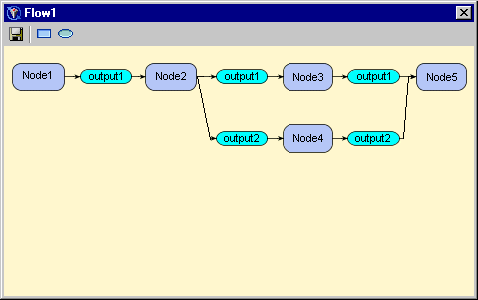Understanding Events and Process Flows
Overview of Events
The Event Broker
Service configuration enables you to configure one or more events.
When an event is received, the Event Broker Service maps the event
name to a configured event name. If an unstructured event is received,
the Event Broker Service maps the unstructured event to a configured
default event name.
the name of the event
in the incoming XML request maps to the configured event name. You
can also name events so that they are part of a naming hierarchy.
Events in a naming hierarchy are separated by a period. For example:
Animals, Animals.Dogs, Animals.Dogs.Retriever. Naming hierarchies are handled
differently based on the event type:
-
If a request/response event is received, it is delivered to a single handling agent. If the incoming request contains an event name that does not exactly match an event name in the Event Broker Service configuration, the naming hierarchy is searched for the best possible event name match that is also configured as a request/response event type.
events can be one
of the following types:
-
-
To authenticate and authorize the sender's credential, select the Check sender's authorization. If you select the Check sender's authorization property, then the event's process flows will not run unless the sender's credentials are successfully authenticated by the SAS Metadata Server's authentication provider and then authorized by the SAS Metadata Server's authorization facility as having the Execute permission for the event.Note: The sender's event request must contain the sender's user ID and password, and can also contain the authentication domain. You can configure a default authentication domain in the configuration for the User Service (see Additional Security Configuration). If you configure a default authentication domain in the User Service, then the sender is not required to specify the authentication domain in the event request.
-
The following
table summarizes information about the incoming event request/response
type and configured event type.
Additional Security Configuration
-
Create, configure, and deploy the User Service (of the SAS Foundation Services). You must configure and deploy the User Service as part of the Event Broker Service's service deployment. The User Service must be available to the Event Broker Service at run time.To authenticate users, the User Service requires an appropriate login module configuration file. In addition, other Java 2 policy and JAAS policy files might be required. For example, to run an event's process flows under a particular security context, you must set up subject-based security with the JAAS policy configuration file in order to restrict access to the appropriate resources. For details about required User Service configuration, see the SAS Foundation Services class documentation at
http://support.sas.com/rnd/javadoc/93.For details about additional User Service configuration in the Foundation Services Manager, see Modifying the Session and User Service Configurations.
In addition, to set
up authorization for sender credentials, you must grant the sender
the Execute permission for the event. To grant the Execute permission,
perform the following steps:
Overview of Process Flows
Process flows are used to process
event messages. Process flows contain process nodes, which contain
logic to process messages, and message nodes, which encapsulate the
inputs and outputs for the process nodes.
For broadcast events, you can configure one or more
process flows for an event. For request/response events, you can
configure only one process flow for an event.
You can configure a
process flow by using the Process Flow Editor to define a Process
Flow Diagram (PFD). A process flow configuration consists of the following
elements:
-
Process nodes: a process node is a Java class that can have one or more inputs and outputs. You diagram these inputs and outputs as message nodes. When an event is received and a process flow needs to be instantiated for the event, a run-time flow engine is instantiated. The run-time flow engine calls a process node by instantiating the Java class associated with that node. Currently, all process nodes are executed synchronously. A process node configuration consists of the following:
